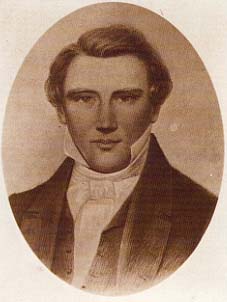Image Details

Courtesy of the Library of Congress
Joseph Smith’s vision in 1827 led him—by his own account—to find and decipher the Book of Mormon and to establish the Mormon Church. Born in Vermont in 1815, Joseph and his parents moved to Palmyra, New York, where a vision, Smith says, led him to unearth the golden plates of the Book of Mormon on a hill near his house. He called these plates “a revision of Egyptian hieroglyphics” and said that they were a more complete version of Jesus’ gospel, which had been revealed to early inhabitants of America. Smith relates that he deciphered the plates with the aid of two optical instruments found with them; then, standing behind a curtain, he dictated the contents of the plates to several scribes. In 1830, the first edition of the Book of Mormon was printed and, in that same year, the 25-year-old Smith and six others founded the Mormon church, known today as the Church of Jesus Christ of the Latter Day Saints.
Seeking a place where he and his followers could settle, Smith traveled westward across the country. Unwelcome with their unfamiliar beliefs, the Mormons were expelled from Kirtland, Ohio, and Far West, Missouri, before they moved to Nauvoo, Illinois, where they established a large community. Still hated and suspected, Smith was arrested in 1844 and three days later, in his jail cell at Carthage, Illinois, he was killed by a mob. Continuing to seek a place where they could live unmolested, more than 1,000 Mormons, led now by Brigham Young, left Illinois. Their trek ended in the Salt Lake Valley in Utah—still the thriving center of the Mormon Church.
